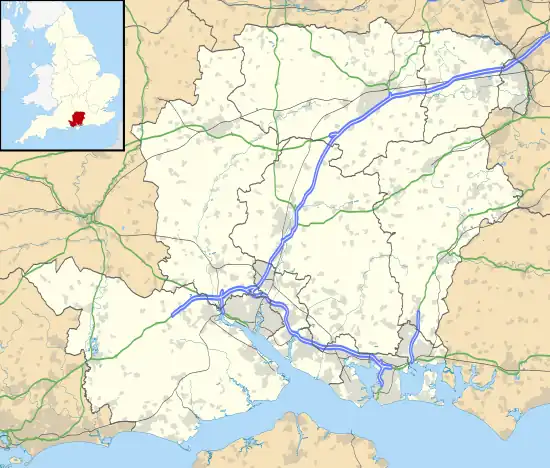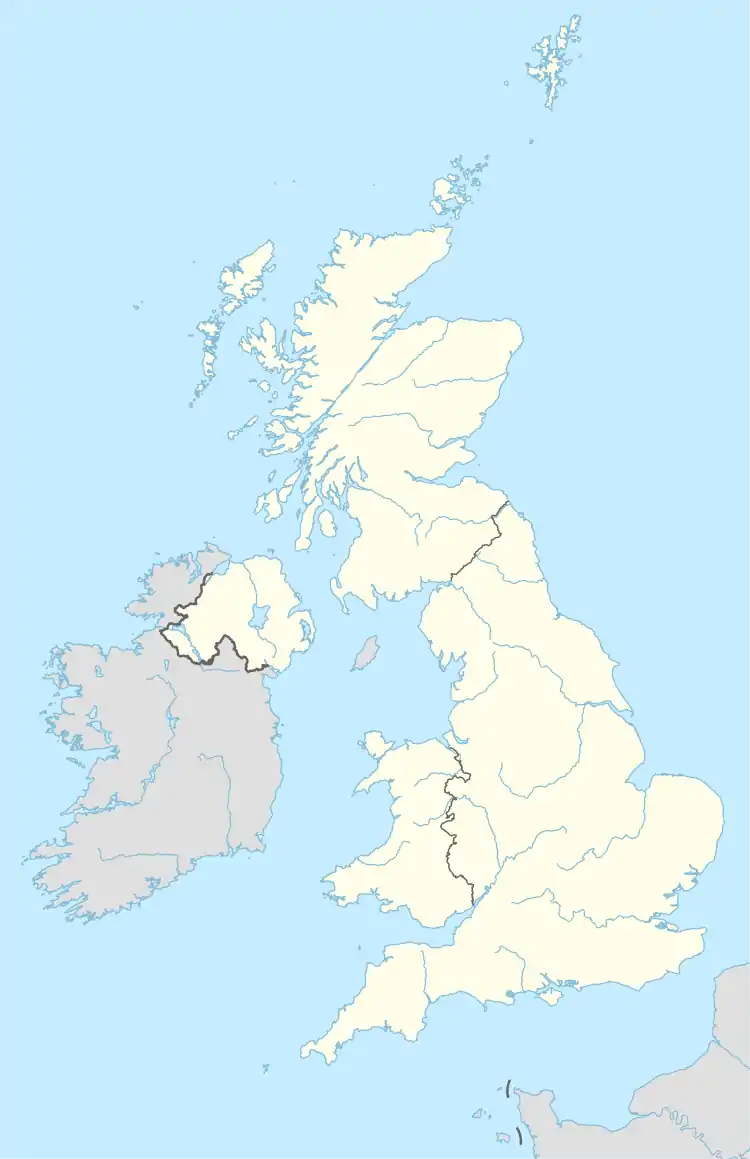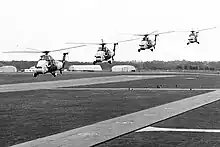RNAS Lee-on-Solent (HMS Daedalus)
Royal Naval Air Station Lee-on-Solent (HMS Daedalus) is a former Royal Naval Air Station located near Lee-on-the-Solent in Hampshire, approximately four miles west of Portsmouth on the coast of the Solent at grid reference SU560019. It was one of the primary shore airfields of the Fleet Air Arm and was first established as a seaplane base in 1917 during the First World War, it later became the main training establishment and administrative centre of the Fleet Air Arm.
| RNAS Lee-on-Solent (HMS Daedalus) | |||||||||||
|---|---|---|---|---|---|---|---|---|---|---|---|
| Lee-on-the-Solent, Hampshire in England | |||||||||||
 RNAS Lee-on-Solent Shown within Hampshire  RNAS Lee-on-Solent RNAS Lee-on-Solent (the United Kingdom) | |||||||||||
| Coordinates | 50°48′54″N 001°12′16″W | ||||||||||
| Type | Royal Naval Air Station | ||||||||||
| Site information | |||||||||||
| Owner | Admiralty | ||||||||||
| Operator | Royal Navy - Fleet Air Arm | ||||||||||
| Site history | |||||||||||
| Built | 1917 | ||||||||||
| In use | 1917 - 1996 | ||||||||||
| Battles/wars | European theatre of World War II Cold War | ||||||||||
| Airfield information | |||||||||||
| Elevation | 9 metres (30 ft) AMSL | ||||||||||
| |||||||||||
The airfield closed for military use in 1996 and passed through several owners until 2014 when Fareham Borough Council bought the airfield and re-branded as Solent Airport Daedalus. The airfield hosts the Solent Enterprise Zone.
History
Naval aviation began at Lee-on-Solent on 30 July 1917 when the Royal Naval Air Service (RNAS) opened the Naval Seaplane Training School as an extension to the seaplane training station at nearby Calshot (under 5 miles across Southampton water by seaplane, but over 30 miles by the shortest land route). The school's first commander was Squadron Commander Douglas Evill. Initially, aircraft had to be transported from their temporary hangars to the top of the nearby cliff, then lowered by crane onto a trolley which ran on rails into the sea. Permanent hangars, workshops, accommodation and a new double slipway were soon constructed, however.[1]
Royal Air Force use
On 1 April 1918, the RNAS combined with the Royal Flying Corps (RFC) to form the Royal Air Force (RAF) and the Lee-on-Solent Naval Seaplane Training School became an RAF station. Naval aviation training continued throughout the 1920s under the RAF with both Calshot and Lee-on-Solent providing training in operating seaplanes - initially using the wartime Short Type 184s and, from late 1921, the new Fairey IIID.[2] On 1 April 1924, the Fleet Air Arm of the Royal Air Force was formed, encompassing those RAF units that normally embarked on aircraft carriers and fighting ships (including those at shore bases such as Lee-on-Solent).[3]
In 1931 the first grass airstrip at Lee was constructed to the west of the town, Lee-on-Solent became HQ RAF Coastal Area, and a major rebuilding programme ensued.[4] On 14 July 1936, an expanded RAF Coastal Area became RAF Coastal Command, with the HQ remaining at Lee-on-Solent.[2]
Royal Navy use
With the expansion of the RAF during the 1930s, however, Parliament decided that the Fleet Air Arm should transfer to the Admiralty.[4] As a consequence, on 24 May 1939, HQ RAF Coastal Command moved to Northwood and Lee-on-Solent was commissioned as HMS Daedalus, becoming Headquarters of Flag Officer Air (Home).[2]
Second World War
During the Second World War a number of naval air squadrons were posted or formed here at some point.
Post-war

Post-war she continued to play a significant role, being renamed HMS Ariel on 31 October 1959 to reflect her electrical, radar and ground training emphasis; she took over the work of the Royal Naval Air Electrical Training Establishment, Worthy Down prior to its closure in 1961.[5] In 1962 the Joint Service Hovercraft Unit was formed with the aim of testing hovercraft in an operational military environment, and soon after the Air Station reverted to the name HMS Daedalus on 5 October 1965.[2]
She was home to the Naval Air Trial Installation Unit (NATIU), formed to install and test new systems in a variety of flying test bed aircraft including a Hawker Hunter and a de Havilland Devon.
Squadrons
The following units were here at some point:[6]
- 700 Naval Air Squadron
- 701 Naval Air Squadron
- 702 Naval Air Squadron
- 703 Naval Air Squadron
- 705 Naval Air Squadron
- 708 Naval Air Squadron
- 710 Naval Air Squadron
- 712 Naval Air Squadron
- 716 Naval Air Squadron
- 728C Naval Air Squadron
- 739 Naval Air Squadron
- 746 Naval Air Squadron
- 752 Naval Air Squadron
- 753 Naval Air Squadron
- 754 Naval Air Squadron
- 760 Naval Air Squadron
- 763 Naval Air Squadron
- 764 Naval Air Squadron
- 765 Naval Air Squadron
- 770 Naval Air Squadron
- 'X' Squadron[7]
- 771 Naval Air Squadron
- 772 Naval Air Squadron
- 773 Naval Air Squadron
- 776 Naval Air Squadron
- 778 Naval Air Squadron
- 780 Naval Air Squadron
- 781 Naval Air Squadron
- 782 Naval Air Squadron
- 783 Naval Air Squadron
- 784 Naval Air Squadron
- 793 Naval Air Squadron
- 798 Naval Air Squadron
- 799 Naval Air Squadron
- 800 Naval Air Squadron
- 801 Naval Air Squadron
- 802 Naval Air Squadron
- 803 Naval Air Squadron
- 804 Naval Air Squadron
- 805 Naval Air Squadron
- 807 Naval Air Squadron
- 808 Naval Air Squadron
- 809 Naval Air Squadron
- 810 Naval Air Squadron
- 811 Naval Air Squadron
- 812 Naval Air Squadron
- 813 Naval Air Squadron
- 814 Naval Air Squadron
- 815 Naval Air Squadron
- 816 Naval Air Squadron
- 817 Naval Air Squadron
- 818 Naval Air Squadron
- 819 Naval Air Squadron
- 820 Naval Air Squadron
- 821 Naval Air Squadron
- 822 Naval Air Squadron
- 823 Naval Air Squadron
- 824 Naval Air Squadron
- 825 Naval Air Squadron
- 826 Naval Air Squadron
- 827 Naval Air Squadron
- 828 Naval Air Squadron
- 829 Naval Air Squadron
- 830 Naval Air Squadron
- 831 Naval Air Squadron
- 832 Naval Air Squadron
- 833 Naval Air Squadron
- 835 Naval Air Squadron
- 836 Naval Air Squadron
- 837 Naval Air Squadron
- 841 Naval Air Squadron
- 842 Naval Air Squadron
- 845 Naval Air Squadron
- 847 Naval Air Squadron
- 848 Naval Air Squadron
- 849 Naval Air Squadron
- 850 Naval Air Squadron
- 854 Naval Air Squadron
- 855 Naval Air Squadron
- 878 Naval Air Squadron
- 881 Naval Air Squadron
- 884 Naval Air Squadron
- 885 Naval Air Squadron
- 886 Naval Air Squadron
- 887 Naval Air Squadron
- 888 Naval Air Squadron
- 891 Naval Air Squadron
- 892 Naval Air Squadron
- 894 Naval Air Squadron
- 895 Naval Air Squadron
- 897 Naval Air Squadron
- 1700 Naval Air Squadron
- 1701 Naval Air Squadron
- 1702 Naval Air Squadron
- 1703 Naval Air Squadron
- 1791 Naval Air Squadron
- 1792 Naval Air Squadron
- 1831 Naval Air Squadron
Units
- Naval Air Radio Installation Unit[8]
- 3rd Naval Fighter Wing
- 20th Carrier Air Group
- 51st Miscellaneous Air Group
- No. 1 Gunnery Co-operation Flight RAF
- No. 2 Anti-Aircraft Co-operation Unit RAF
- No. 10 Group RAF
- No. 15 (General Reconnaissance) Group RAF
- No. 16 (Reconnaissance) Group RAF
- No. 16 Squadron RAF
- No. 17 Group Communications Flight RAF
- No. 17 (Training) Group RAF
- No. 18 (Reconnaissance) Group RAF
- No. 26 Squadron RAF
- No. 42 Squadron RAF
- No. 63 Squadron RAF
- No. 202 Squadron RAF
- No. 209 Training Depot Station RAF
- No. 407 (Fleet Fighter) Flight RAF
- No. 407 (Fleet Reconnaissance) Flight RAF
- No. 440 (Fleet Reconnaissance) Flight RAF
- No. 441 (Fleet Reconnaissance) Flight RAF
- No. 441 (Fleet Spotter Reconnaissance) Flight RAF
- No. 442 (Fleet Reconnaissance) Flight RAF
- No. 443 (Fleet Spotter Reconnaissance) Flight RAF
- No. 444 (Fleet Reconnaissance) Flight RAF
- No. 444 (Fleet Spotter Reconnaissance) Flight RAF
- No. 445 (Fleet Spotter Reconnaissance) Flight RAF
- No. 700H Flight
- No. 701 (Catapult) Flight RAF
- No. 716 (Catapult) Flight RAF
- No. 1320 ('Abdullah') Flight RAF
- Air Spotting Pool RAF
- Coastal Area RAF
- RAF Coastal Command
- Fleet Requirements Unit RAF
- Floatplane Training Flight RAF
- RAF & Naval Co-operation School
- RAF Seaplane Establishment
- School of Naval Co-operation RAF
- School of Naval Co-operation and Aerial Navigation RAF
- School of RAF and Naval Co-operation and Navigation RAF
- Seaplane Club RAF
- Seaplane Training School RAF
- Seaplane Training Squadron RAF
- Southampton University Air Squadron
- VCS-7
The military site was deactivated during 1996.
Solent Airport Daedalus (2015-present)
Since 2015 the site is now Solent Airport Daedalus
See also
References
Citations
- "Fleet Air Arm". FAA Archive. Archived from the original on 9 May 2008.
- "HMS DAEDALUS HERITAGE - 1930s". Fleet Air Arm Archive Archive. Archived from the original on 11 May 2008.
- RAF Museum Milestones of Flight - 1924 Archived 2 October 2006 at the Wayback Machine
- "Report on HMS Daedalus for the Defence Heritage and Tourism Panel, Hampshire County Council - 30 November 1999". Archived from the original on 30 September 2007.
- "Copy of government briefing paper" (PDF).
- "Lee-on-Solent". Airfields of Britain Conservation Trust. Retrieved 14 April 2015.
- R.A.F. Form 543 T/Cpl Thomas Barker Fitt IIE. Date of Movement 30/08/41 to 'X' Squadron Lee
- Howard 2011, p. 62.
Bibliography
- Howard, L; Burrow, M; Myall, E (2011). Fleet Air Arm helicopters since 1943. UK: Air-Britain (Historians) Ltd. ISBN 978-0-85130-304-8.
![]() Media related to RNAS Lee-on-Solent (HMS Daedalus) at Wikimedia Commons
Media related to RNAS Lee-on-Solent (HMS Daedalus) at Wikimedia Commons